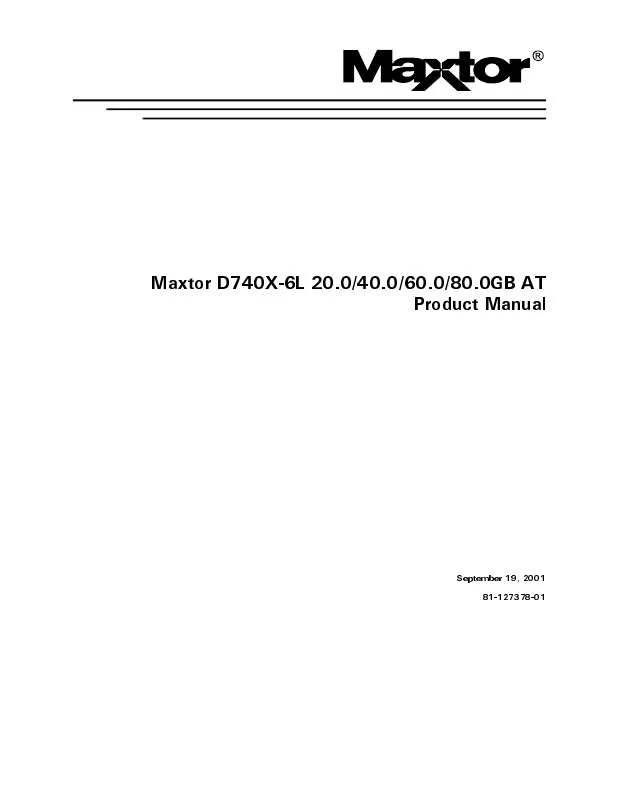User manual MAXTOR D740X-6L 09-19-2001
Lastmanuals offers a socially driven service of sharing, storing and searching manuals related to use of hardware and software : user guide, owner's manual, quick start guide, technical datasheets... DON'T FORGET : ALWAYS READ THE USER GUIDE BEFORE BUYING !!!
If this document matches the user guide, instructions manual or user manual, feature sets, schematics you are looking for, download it now. Lastmanuals provides you a fast and easy access to the user manual MAXTOR D740X-6L. We hope that this MAXTOR D740X-6L user guide will be useful to you.
Lastmanuals help download the user guide MAXTOR D740X-6L.
Manual abstract: user guide MAXTOR D740X-6L09-19-2001
Detailed instructions for use are in the User's Guide.
[. . . ] T G D O GV R G 5
NCWPC/ VEWFQT2 6# $) . :& TQVZC/
©
September 19, 2001 Maxtor Corporation. Printed in U. S. A.
This publication could include technical inaccuracies or typographical errors. Changes are periodically made to the information herein which will be incorporated in revised editions of the publication. [. . . ] Adaptive segmentation allows the drive to make optimum use of the buffer. The amount of stored data can be increased.
DisCache anticipates host-system requests for data and stores that data for faster access. When the host requests a particular segment of data, the caching feature uses a prefetch strategy to "look ahead", and automatically store the subsequent data from the disk into high-speed RAM. If the host requests this subsequent data, the RAM is accessed rather than the disk. Since typically 50 percent or more of all disk requests are sequential, there is a high probability that subsequent data requested will be in the cache. This cached data can be retrieved in microseconds rather than milliseconds. As a result, DisCache can provide substantial time savings during at least half of all disk requests. In these instances, DisCache could save most of the disk transaction time by eliminating the seek and rotational latency delays that dominate the typical disk transaction. For example, in a 1K data transfer, these delays make up to 90 percent of the elapsed time. DisCache works by continuing to fill its cache memory with adjacent data after
Maxtor D740X-6L 20. 0/40. 0/60. 0/80. 0GB AT 5-10
T A B G 0 . 0 2 L 6 - X 0 4 7 D r ot x a M 1 1 - 5
UVKHGPG$ GEPCOTQHTG2
noitarepO fo selpicnirP cisaB
transferring data requested by the host. Unlike a noncaching controller, Maxtor's disk controller continues a read operation after the requested data has been transferred to the host system. This read operation terminates after a programmed amount of subsequent data has been read into the cache segment. The cache memory consists of a 1. 9MB DRAM buffer allocated to hold the data, which can be directly accessed by the host by means of the READ and WRITE commands. The memory functions as a group of segments with rollover points at the end of cache memory. The unit of data stored is the logical block (that is, a multiple of the 512 byte sector). Therefore, all accesses to the cache memory must be in multiples of the sector size. Almost all non-read/write commands force emptying of the cache:
GJEC% GVKT9
When a write command is executed with write caching enabled, the drive stores the data to be written in a DRAM cache buffer, and immediately sends a GOOD STATUS message to the host before the data is actually written to the disk. The host is then free to move on to other tasks, such as preparing data for the next data transfer, without having to wait for the drive to seek to the appropriate track, or rotate to the specified sector. While the host is preparing data for the next transfer, the drive immediately writes the cached data to the disk. WriteCache allows data to be transferred in a continuous flow to the drive, rather than as individual blocks of data separated by disk access delays. This is achieved by taking advantage of the ability to write blocks of data sequentially on a disk that is formatted with a 1:1 interleave. [. . . ] Hard disks are generally made of aluminum or magnesium alloy (or glass, for optical disks) while the substrate of floppies is usually mylar. SURFACE The top or bottom side of the platter which is coated with the magnetic material for recording data. On some drives one surface may be reserved for positioning information.
U
UNFORMATTED CAPACITY The total number of bytes of data that could be fit onto a disk. Formatting the disk requires some of this space to record location, boundary definitions, and timing information. [. . . ]
DISCLAIMER TO DOWNLOAD THE USER GUIDE MAXTOR D740X-6L Lastmanuals offers a socially driven service of sharing, storing and searching manuals related to use of hardware and software : user guide, owner's manual, quick start guide, technical datasheets...manual MAXTOR D740X-6L


